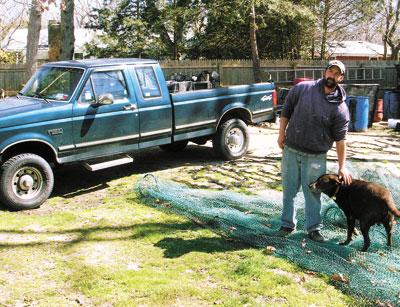A 13th-Generation Perspective

Nat Miller stood in the basement workroom of his house in Springs last week mending a section of net soon to be part of the labyrinth of mesh that corrals fish into the parlor section of a fish trap.
Rhumb Line, his elderly chocolate lab, moved gingerly around the mesh curtain as though he’d known of its dangers all of his life, which he has.
Mr. Miller is a 13th-generation East Hampton local. His first child, a boy, is due to enter the world in August, the start of the 14th generation.
He graduated from East Hampton High School with the class of ’97 and, after spending a year crewing on a dragger, won a scholarship to the State University at Oswego. His last class of the week was on Thursdays, and during bass season he would drive seven hours, fish until Monday afternoon, and drive back.
His contemporaries include Paul, Dan, and Kelly Lester, who on Monday stood with other fishermen and their attorney at an outdoor press conference in Amagansett to announce their demand that the State Department of Environmental Conservation pay them for fish seized during a raid on their property. Last year they were found not guilty of violating fishery laws, but were never compensated for the seized fish. A story on this subject appears elsewhere in today’s paper.
Plainspoken in the Bonac tradition, Mr. Miller is perhaps more voluble than many baymen, but not what you’d call chatty. In November, he was elected to be one of nine East Hampton Town Trustees. He has a bachelor’s degree in American history and Native American studies from Oswego, where he found that the upstate locals, “like Bonac, don’t like to move.”
Stuart Vorpahl, a fisherman, former town trustee, and a town historian, is his uncle. Scott Bennett is another uncle. Being dropped off at the beach with a bait barrel and a net was one of his first memories.
“I started on the ocean picking bluefish,” he said. He fished with Calvin Lester. “You didn’t get taught by Calvin, you got ‘lessoned in,’ ” he said with a smile for the late, often cantankerous, hard-working, and talented bayman.
There’s no doubt that Mr. Miller has the Bonac pedigree, and he said it’s what he sees as his East Hampton birthright that brought him to the trustees.
“I have an interest in American history, but the local heritage has had more of an impact. I’m not a politician, but I can’t see complaining and not trying to fix it. I’ve always told myself that for my kid, my grandson — I’d like to think this will be around 400 years from now. The people who live here and love this beautiful place are just as important as someone who takes a billion dollars to make it the way they want it. Money changes everything — the lawyers — but with the trustees they can’t do that.”
He smiled when asked about the trustees’ recent “defeat” in State Supreme Court in the case that pitted the town’s 300-year old government body against Lloyd and Barbara Macklowe, owners of a vast estate on Georgica Beach.
There was no question that the trustees, on behalf of the East Hampton public, own the beach there, and that fishermen have, for hundreds of years, had the right to “cart fish” on it. No doubt that today’s tourists, sportfishermen, and vacationing families can do their equivalent. The legal question was, where does that trustee beach end and the Macklowe property begin?
The Macklowes claimed that a grassy dune had grown seaward due to sand accretion (forming a broader beach), the result of the Georgica jetties, and therefore their property had grown. The trustees argued the southerly border of the Macklowe’s property was established by deeded meets and bounds farther upland.
Last month, Justice Thomas Whelan accepted the Macklowe attorney’s finding that in 1900, for a pittance, the trustees agreed to set the seaward border of the property in question and that of a number of neighboring properties, at the “southernmost line of beach grass on the dunes.”
The trustees have appealed the decision. If the trustees should lose their appeal in the appellate division of the State Supreme Court, the decision will be binding on judges throughout Long Island. John Courtney, the trustee attorney, declined to comment.
Mr. Miller smiled, and spoke about the “foresight” of the centuries-old trustees. “I think it’s a win. They messed their neighbors up good,” he said of the oceanfront property owners. The reason was simple, he said.
If the southern boundary of the Macklowe’s property is established as the seaward extent of dune and beach grass, it follows that when that boundary is inevitably eroded, the trustees will maintain their claim to public beach no matter how far it creeps onto what had been the homeowner’s land.
“We want to stop erosion. We like the idea of a dune ladder,” Mr. Miller said, referring to a wooden structure being tested on trustee-owned beach at Lazy Point that collects and holds sand. “But, once you put in a bulkhead, the beach goes. Then, there’s no beach for the public. If high tide winds up under a house that’s been raised on stilts — an application to do just that is now before the trustees — where’s the public’s access?”
“A home is not an investment. It’s a place to live and raise a family. If a storm comes, [the beach] is more important than one person’s investment. Maybe we’re aware of what our grandparents saw, the doubling effect of development. Here there’s work, and family. It’s not a business venture.”
“Our predecessors never thought about it,” Mr. Miller said, referring to today’s sea-level rise and chronic erosion. Still, he said, they knew enough not to build their houses in close proximity to the ocean. Two Mile Hollow was named for a reason. “It’s a hollow, and the sea is an uncontrollable thing.”
